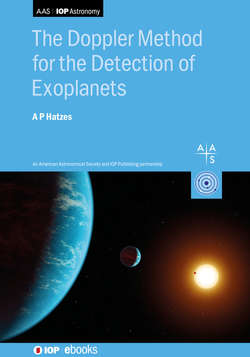Читать книгу The Doppler Method for the Detection of Exoplanets - Professor Artie Hatzes - Страница 13
1.4 The Early Hints of Exoplanets
ОглавлениеAlthough the discovery of 51 Peg b (Mayor & Queloz 1995) is considered as the discovery of the first exoplanet around a Sun-like star, there were hints of discoveries before 19951. Campbell et al. (1988; hereafter CWY) monitored the brighter component of the spectroscopic binary γ Cep using a hydrogen fluoride absorption cell (see Chapter 4). The top panel of Figure 1.5 shows the RV measurements of γ Cep A from CWY. The long-term trend due to the binary motion is obvious, but one can see extra “wiggles.” Removing the linear trend shows clear variations, due to a possible planetary companion. CWY commented that these variations represented a possible third body in the system with a period of ≈3 yr that might be planetary in nature. Unfortunately, Walker et al. (1992) later attributed these variations to rotational modulation, largely because theoretical work could not produce giant planets in short period orbits (G. A. H. W. Walker, 2013, private communication). Hatzes et al. (2003) later demonstrated that these residual RV variations were indeed due to a 1.7 MJup giant planet in a 2.48 yr orbit.
Figure 1.5. (Top) Early RV measurements of γ Cep A made in the 1980s using an H–F absorption cell (Campbell et al. 1988). The trend is due to orbital motion of the binary companion. (Bottom) RV measurements after removing the long-term trend. The RV motion due to the planetary companion can easily be seen (red curve: orbital solution of Hatzes et al. 2003).
Latham et al. (1989) found a possible giant planet with a minimum mass of 11 MJup orbiting HD 114762 with an orbital period of 83.8 days (Figure 1.6). With an eccentricity of e = 0.38, HD 114762 b was the prototype of the so-called massive eccentric planets. These are massive planets (M ≈ 10 MJup) in eccentric (e ≳ 0.3) orbits. The RV measurements were made with “traditional” methods, i.e., without simultaneous wavelength calibration (see Chapter 4), so the measurement error is σ ≈ 400 m s−1. This is comparable to the RV amplitude of ≈600 m s−1 and demonstrates that with sufficient measurements, one can detect a planet with RV amplitude comparable to the measurement error. However, the true nature of the companion is unknown until the orbital inclination is measured. Preliminary results from the GAIA astrometric space mission indicate an orbital inclination of 6.2 degrees which yields a companion mass of 107−2730 MJup, or in the M dwarf star regime (Kiefer 2019)2.
Figure 1.6. The RV variations of HD 114762 due to a planetary candidate companion with an orbital period of 83.8 days and a minimum mass of 11 MJup (Latham et al. 1989). The rms scatter about the orbital solution (red curve) is 412 m s−1 and was typical for high-quality RV measurements before the use of simultaneous wavelength calibration.
Inspired by the early work of Walker et al. (1989), who found RV variations in a sample of K giant stars, Hatzes & Cochran (1993) monitored several of these stars and found long-period RV variations in α Tau, α Boo, and β Gem. They hypothesized that these could be due to giant-planet companions. Indeed, it was later shown that early RV measurements for β Gem were due to a giant planet with M = 2.7 MJup in a 590 day orbit (Hatzes et al. 2006; Reffert et al. 2006).
